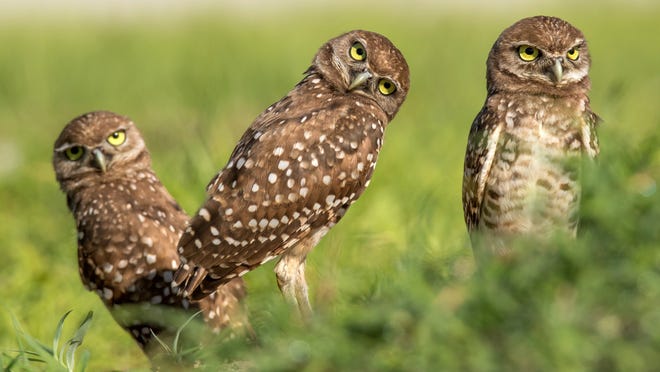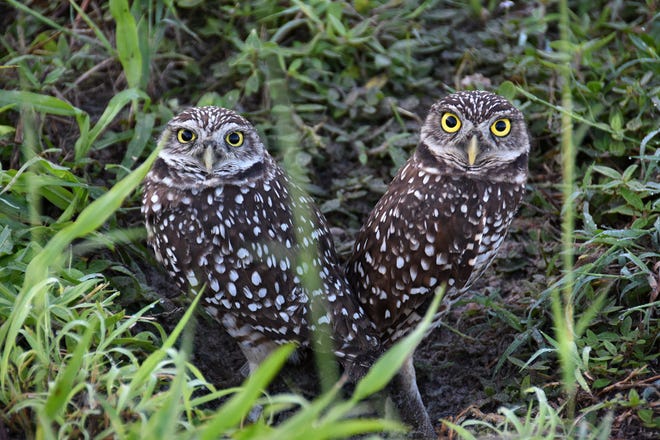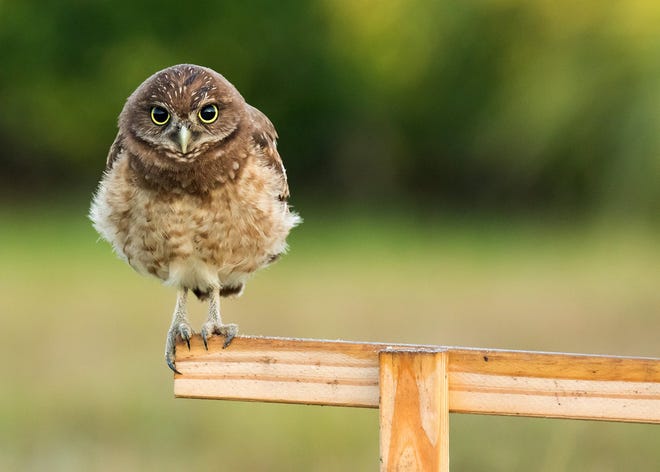Last call for starter owl burrows on Marco Island
 Omar Rodríguez Ortiz
Omar Rodríguez Ortiz
Marco Island residents have until Friday if they want to have starter owl burrows on their front yards, according to Allison Smith, manager of the Owl Watch program.
"Owls are settling into their burrows for nesting season," Smith wrote in a text message on Feb. 14. "They won't be digging new ones until the fall."
"We'll start again in August to try to entice the chicks that hatch this spring."
Burrowing owl nesting season starts in February and ends in July.
We dig a hole one-foot deep at an angle, we pile all the sand next to it so it looks like an owl burrow and we put a wooden perch for them to stand on, Smith said. Then it's just a matter of time before burrowing owls start moving in.
Owl Watch has dug 125 starter burrows as of Feb. 16 and of those 35 were dug after the city's incentive program was announced last month, according to Smith.
From January:Marco will pay homeowners $250 for starter owl burrows
On Jan. 21 City Council approved an agreement to pay homeowners $250 for starter owl burrows on their front yards.
Jared Grifoni, City Council vice-chair, said this program is important to the island's community and wildlife.
"Marco Island is the first in the state to enact a program designed to expand the habitat of a threatened species (while) rewarding citizens who wish to participate voluntarily," Grifoni wrote in an email in January.
"We will be an example of positive and cooperative action to the entire state."
Audubon of the Western Everglades, a grassroots conservation organization in Southwest Florida, is in charge of recruiting property owners, conducting annual site visits and documenting the use of the starter burrows by the owls, according to the agreement.

Audubon's Owl Watch staff and volunteers are also responsible for digging burrows, not the property owners, said Brad Cornell, Audubon's policy director.
"We have had some trouble with folks digging their own, and sometimes in poor spots," Cornell said on Jan 21.
The city will provide grants only if the burrows remain 'potentially occupied' for at least one nesting season, Smith said.
Potentially occupied burrows include active burrows, which contain eggs or are used by flightless chicks and inactive burrows, which have no evident indications of recent occupancy but its entrance remains open, according to Florida Fish and Wildlife Conservation Commission.

The Commission and others will collect data, including capturing, banding, and placing transmitters on burrowing owls and scoping of burrows, according to the agreement.
"We are trying to figure out whether this is an effective way to stabilize an urban owl population in the state of Florida," Cornell said during a City Council meeting in December.
"We have some preliminary numbers that are encouraging but certainly not final."
In the fall of 2017, Owl Watch staff began meeting with Marco homeowners who wanted starter burrows on their front yards.
The vast majority of burrowing owls in Marco live on vacant lots but as people build new houses they may eventually run out of places to live, Smith said. The island is developing pretty rapidly and in 20 years there may not be enough vacant lots.
Property owners interested in the program can call AWE to 239-643-7822 or send an email to owlwatchmarco@gmail.com.
In case you missed it:FWC identifies three collapsed burrows, one dead owl on Marco
More:Marco realtor accused of putting mothballs into owl burrow agrees to 6 months’ probation
Learn about burrowing owls
- Burrowing owls are water bottle-sized birds, standing 7-10 inches tall, and weighing 5-9 ounces, or about as much as a baseball.
- These owls occupied Florida’s prairies north of the Everglades; however, most of these grasslands have been developed.
- Today burrowing owls can be found on prairie remnants and pastures throughout the state, as well as in several coastal cities.
- These owls spend the breeding season in and around their burrows, which they typically dig themselves.
- Male owls can often be seen standing on a nearby perch or at the burrow entrance, watching vigilantly for predators or passing prey while females and young chicks stay below ground.
- Outside nesting season, these owls seek shelter in a variety of places outside their burrow like shrubs, trees, porches and dry culverts.
- Burrowing owl's main threat is the continued loss of habitat, including construction activities, and harassment by humans and domesticated animals.
- Heavy floods can also destroy burrows, which can cause the destruction of eggs and owlets.
- Other threats include increased predation by ground and aerial predators in the burrowing owl’s habitat, and vehicle strikes.
- Burrowing owls are designated by the state as a threatened species.
- Taking, possessing or selling burrowing owls, their nests or eggs is prohibited without a permit.
Sources: AWE & Florida Fish and Wildlife Conservation Commission
Omar Rodríguez Ortiz is a community reporter for Naples Daily News and Marco Eagle. Follow him on Twitter and Instagram as @Omar_fromPR, and on Facebook. Support his work by subscribing to Naples Daily News.